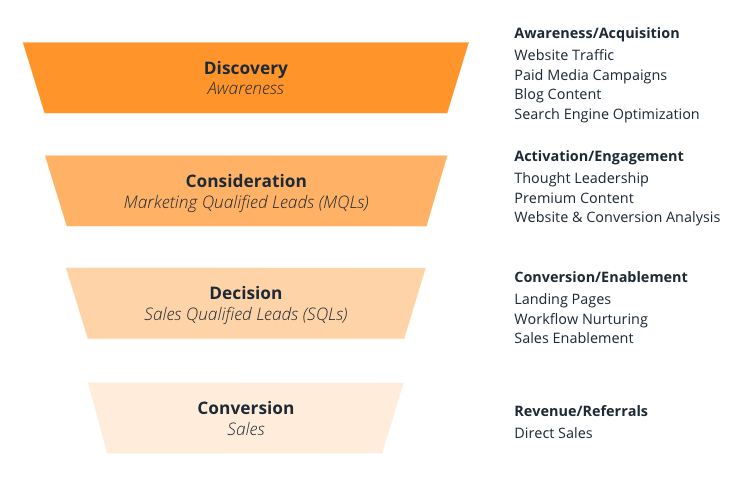How to Create a Successful Digital Marketing Strategy
Today’s consumers demand a more personalized marketing approach, which means traditional marketing is out, and inbound marketing is in!
Inbound marketing is all about creating and sharing relevant, targeted content online and with a specific audience. Inbound marketing seeks to attract qualified prospects with content they actually want to see, and where and when they want to see it.
However, before implementing your ideal inbound marketing campaign, it’s crucial that you develop a digital strategy.
A good digital strategy provides a clear direction and outline of how you’ll communicate and promote your business to your targeted audience across all digital marketing methods, including social media, email marketing, paid media, SEO etc.
How to Create a Digital Marketing Strategy:
1. Identify the target audience
2. Analyze past marketing metrics
3. Perform a SWOT analysis
4. Define your marketing goals
5. Determine your marketing channels
6. Keep in mind the lifecycle stages and marketing funnel
7. Create a marketing plan
8. Report and measure progress
1. Identify the target audience
The beginning of every marketing strategy should be the development of your target audience personas. The whole point of marketing is to reach high-quality leads that eventually become customers, so you’ll want to first ask yourself, “what does a quality lead look like for my business? You can have a great marketing strategy in place, but if you don’t know who you’re trying to reach then your strategy is not going to be aligned or successful.
Start by identifying what qualifications make up your target persona. Is it someone with a specific job title, industry, or location? Really dig deep into who your persona is. What questions, pain points or problems do they have? What are their motivations? How do they consume information? It might sound nitty-gritty, but the more clearly defined your audience is, the more capable you are of reaching that audience and informing them that your product or service is the solution to their challenges.
Keep in mind that you should regularly reevaluate and align your personas using Google Analytics and Facebook’s Audience Insights to ensure your current audience is still inline with your target personas. You made need to update your personas to match your new business strategy or vice versa.
2. Analyze past marketing metrics
The best way to create a strategy for the new year is to look at your past metrics to see what worked and what didn’t work. Especially in an event like a global pandemic, consumer behavior is bound to change and you’ll want to review your past metrics to make the appropriate adjustments. When is your audience spending most of its time online? What platforms are they engaging with? What kind of content are they interested in? These are the kinds of questions and metrics you’ll want to review to get an idea of what your 2021 strategy should include, change, or exclude.
3. Perform a SWOT analysis
Perform an audit of your business and your competitors using a SWOT analysis to identify your strengths, weaknesses, opportunities, and threats. Here you’ll start to identify your differentiators and what you should focus on as your value proposition when communicating with your audience. A SWOT analysis will also help you eliminate any missed opportunities by understanding what your business is currently lacking and what you need to improve or adjust in your future strategy.
4. Define your marketing goals
You’ve identified the key components of your business, now it’s time to identify your goals. Your marketing goals should be the foundation of your marketing plan and strategy and ultimately be tied to the success of your business’s overall growth. They’ll not only drive what you do but also how you’ll do it.
First, you’ll want to understand your overall business goals to ensure your marketing efforts are relevant to the bigger picture. Then you’ll want to start drafting SMART goals so it’s clear what you want to achieve and how you’ll go about doing it.
5. Determine your marketing channels
Next, you’ll want to identify the different marketing channels needed for your strategy in order to reach your audience and convert customers. While your marketing strategy doesn’t need to incorporate all of the different digital marketing channels, here’s a general outline of each:
- Content Creation: Creating content, like blogs or downloadable resources, that inform, educate, and bring your audience one step closer to understanding the value of your business.
- SEO: Search engine optimization includes keyword research, technical optimizations, and strategic content creation to improve high-quality organic search traffic.
- Social media: Your social media strategy should promote your product or service on social platforms and can help build brand awareness, interest, relationships, and credibility.
- Paid media: To reach a wider range of targeted audiences you can use paid media tactics, such as PPC or social media ads.
- Email marketing: This includes sending emails directly to your audience’s inbox that promote your product or service, or nurture them down the funnel.
- Website: Your website is your audience’s first impression of your site and should be informative, engaging, and optimized.
- Analytics: You should use reports and analytics to constantly evaluate the ROI of your marketing efforts and decide what adjustments need to be made (if any).
6. Keep in mind the lifecycle stages and marketing funnel
When creating a digital strategy that offers a cohesive experience for your audience it’s important to keep in mind the marketing funnel and the different lifecycle stages. You’ll want to ensure each channel and each stage of the funnel are working together to push customers towards becoming a customer.
- Discovery Stage: In this stage, your prospect is just getting acquainted with your brand and is beginning to realize they have a need for your product or service.
- Consideration: Your prospect has identified that they have a problem and is researching potential solutions, including your product or service.
- Decision: In this stage, your prospect is examining the options and beginning to narrow down the list of possible vendors.
- Conversion: Your prospect has decided they want to buy from your business.
Here’s an example of what your marketing funnel might look like:

7. Create a marketing plan
Now that you’ve decided what marketing channels will be beneficial to your business and goals, it’s time to start drafting a plan.
- Messaging: Define your message to provide a blueprint for how you should go about creating content for your business and promoting your business. How will your business talk about itself? What value does your business provide to your audience?
- Content Calendar: Putting together a calendar that schedules out your content and cadence will be extremely beneficial for the organization of your campaign strategy. Write down a list of all the tasks that you’ll need for your campaigns, such as testimonials, landing pages, email workflows, social media posts, downloadable resources, etc., and schedule them out accordingly.
- Tools: What are the tools and resources required? Take a look at the top marketing tools to decide what will be beneficial to help accomplish your marketing strategy.
8. Report and measure progress
Lastly, be sure to check your progress and success of your strategy by constantly monitoring your marketing metrics. Take note of what’s working and what’s not and then make adjustments to your marketing strategy or messaging that could improve your marketing’s performance.
Digital Strategy Consultation
Putting together a marketing strategy takes a lot of time and work to ensure you’re set up for success. If you don’t have the time or bandwidth to put together a digital strategy, or if you’re not sure if your current plan is up to par then contact your digital experts at Pyxl. We’ll provide you with a quick digital strategy consultation to discover how we can take your business to the next level in 2021.
Updated: Jan 18, 2023
 Kati Terzinski
Kati Terzinski
 Erin Murray
Erin Murray